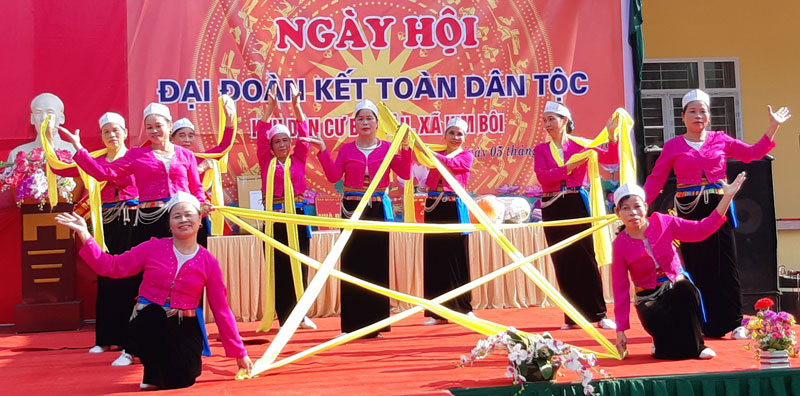
(HBO) - Boi Cau Hamlet, Kim Boi Commune, Kim Bôi district, Hoa Binh province organized the great national unity day. Mr. Bui Van Cuu, Vice Chairman of the Provincial People's Committee attended.
People of Boi Cau hamlet perform arts to celebrate the great national unity day.
After reviewing the tradition of the Fatherland Front of Vietnam, Boi Cau hamlet has highlighted outstanding results in the campaign "All people unite to build new rural areas and civilized cities".
There are 387 households in Boi Cau hamlet with 2 people of Muong, Kinh live together, in which, Muong people account for 98%.
In 2019, per capita income reached 32 million VND, poor households reduced to 7 households. 100% children in school-age go to school. Cultural activities, sports regularly maintained. 72% households reach cultural families, 96% of sports households. Boi Cau is recognized by the District People's Committee as a cultural residential area.
Speaking at the festival, Mr. Bui Van Cuu, Vice Chairman of the Provincial People's Committee praised the results of Boi Cau hamlet. At the same time, he recommended that the hamlet continue to unite and build an increasingly developed residential area, preserve cultural identity and maintain a cultural residential area.
On this occasion, the Commune People's Committee awarded certificates of merit to 16 typical families in the campaign "All people unite to build new rural areas and civilized cities".
Hoa Binh province has carried out multiple programmes and initiatives to revive its cultural heritage which has gradually fallen into oblivion through the ebbs and flows of history.
The most prominent and defining feature in the prehistoric era of Hoa Binh is the Hoa Binh Culture. The Culture was first discovered in Hoa Binh. The significant prehistoric culture represents not only Vietnam but also Southeast Asia and southern China. Through excavations of cave sites in the limestone regions of Hoa Binh, French archaeologist M. Colani introduced the world to a "Stone Age in Hoa Binh province – Northern Vietnam" in 1927. On January 30, 1932, the First Congress of Far Eastern Prehistorians, held in Hanoi, officially recognised the Hoa Binh Culture.
Known as the "Land of Epic History”, Hoa Binh province, the gateway to Vietnam’s northwest, boasts a strategic location and a unique cultural tapestry woven by its ethnic minority communities.
The People's Committee of Luong Son District recently held a ceremony to receive the certificate recognizing Sau Communal House in Thanh Cao Commune as a provincial-level historical and cultural site.
Recognising the importance of cultural heritage preservation in protecting and promoting the value system of Vietnamese culture, and serving socio-economic development in the new period, Party committees and local administrations in Hoa Binh province have identified it as a key task in the cultural development strategy. The province has been making efforts in mobilising resources, creating consensus among people and engaging ethnic communities in preserving and promoting cultural identity.
Hoa Binh province has captured growing attention both domestically and internationally for its distinctive cultural heritage and rich history. Most notably, it has been renowned for its famous Hoa Binh culture, considered the cradle of ancient Vietnamese civilisation. Looking ahead to significant milestones in 2025 and the 140th anniversary of province establishment in 2026, Hoa Binh Newspaper presents a comprehensive overview of the province's development across economic, social, cultural, tourism, and security domains.



